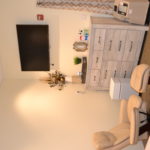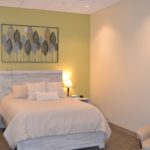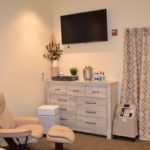Accredited by the American Academy of Sleep Medicine (AASM), we are a state-of-the-art, comfortable Sleep Center conveniently located in the Riverside section of East Providence, RI. Our suite features two private, quiet patient sleep rooms with décor, lighting and furnishings similar to that of a hotel bedroom including, queen size bed, wall-mounted flat screen TV, and personal temperature controls. Most major insurances are accepted, and we operate seven nights a week for scheduling your sleep study at your convenience.
Frequently Asked Questions
What is a sleep study?
A sleep study, also known as “polysomnogram,” is a noninvasive, pain-free procedure that usually requires spending a night in a sleep center. During a polysomnogram, a sleep technologist records multiple biological functions that occur while asleep, such as brain wave activity, eye movement, muscle tone, heart rhythm and breathing via monitors placed on the head, chest and legs and applied with odorless, soluble paste, tape and non-restrictive fabric bands.
What happens when I get there?
Upon arrival for your sleep study, you will be greeted by the sleep technologist. Once you have been greeted and identification has been verified, you will be escorted to your sleep room. Your sleep room is set up similar to a hotel room, which includes a full-size bed with 2 pillows, a recliner chair, TV/cable/WiFi, personal temperature control unit, bottled water/snacks and personal storage chest. Bathrooms/showers are located outside of the patient sleep room.
The sleep technologist will review your patient questionnaire and ensure that all the information needed for the test is up-to-date and accurate. The technologist will go over any questions you may have prior to the study. Depending on the physician’s orders, patients may be given therapy during the course of the study, which may include medication, oxygen or positive airway pressure therapy delivered through a device called CPAP or BiPAP.
Once the sleep sensors are applied, you may read or watch TV in bed until you are sleepy, according to your usual routine. The technicians will stay in a separate control room to watch a computer monitor record your sleep information.
Can I use the bathroom?
Many people have to use the bathroom during the night. If that occurs, the monitoring equipment can be unplugged quickly and taken with you into the bathroom. Simply notify the technician for assistance with the equipment.
Can someone stay with me?
A family member or attendant may stay if medically necessary and approved by the sleep staff. There are recliner chairs in all the bedrooms. However, if the family member snores or otherwise disrupts the sleep of the person being tested, this can sometimes cause problems with the testing. Family members are not allowed to share the same Sleep Center bed.
What happens after the test?
After a full night’s sleep is recorded, the data will be tabulated by our scoring technologist and provided to a physician for interpretation. Once the physician receives the results, the results are copied into a formal sleep study report and forwarded to the physician who referred you to our lab. Please allow 2 weeks to complete this process.
Explanation of Testing
The following is an explanation of the tests that are performed at the Brown Medicine Sleep Center. You will be scheduled for one (1) or possibly two (2) of these tests. Your provider will inform you of what test(s) you are having performed at the time of your initial evaluation. The sleep technologist will confirm this before the study.
Overnight “Baseline” Sleep Study:
This test is performed to diagnose sleep disorders such as sleep apnea and periodic limb movement disorder. The test will begin once you are asleep. As you sleep, non-invasive, flexible equipment attached to your head and body monitor your brain waves, breathing, and movement. A technician watches as you sleep via a discreet camera. You are woken up at approximately 5:30 AM.
PAP Titration Study (Positive-Airway-Pressure Titration):
This test is performed if you are found to have obstructive sleep apnea, central sleep apnea, or hypoventilation with hypoxemia. This test cannot be performed until one of those diagnoses have been confirmed. Once you are diagnosed, you may need a PAP titration study before you can begin treatment.
A PAP titration study is an in-lab sleep study used to determine the best settings for treating your sleep disordered breathing. During the test, the technologist will help you find the best mask/interface and adjust the therapy, therefore the settings are personalized for you. The most common titration study is Continuous Airway Pressure (CPAP) therapy. CPAP is the first line therapy for treating most sleep-related breathing disorders. This is a highly effective therapy, whereby a mask is worn over the nose during sleep. Pressure from a small medical air compressor delivers air through your nasal passages and into the airway under gentle pressure, keeping it open and allowing you to sleep and breathe normally.
In some cases, CPAP does not work well for a patient’s condition, or another mode of therapy is needed to fully control the sleep disordered breathing. In this case, your clinician may order a similar test, for example a BiPAP or Bilevel Titration study or adaptive servo ventilation (ASV) study.
½ CPAP or ½ BiPAP:
This is a combination overnight sleep study and positive airway pressure titration. Once you are asleep, you will be monitored during the first half of the night to confirm that you have sleep apnea. This is termed a “baseline” period. If you are found to have moderate or severe obstructive sleep apnea, then CPAP or BiPAP titration will begin during the second half of the night.
Directions
The Brown Medicine Sleep Center, located at Brown Medicine Patient Center is accessible by car and public transportation.
To reach our location using public transportation please see the details below which have been furnished by RIPTA. If you have any questions regarding how to reach us via public transportation please contact RIPTA directly at 401-781-9400 or at www.ripta.com.
Originating from Kennedy Plaza in Providence:
- Board the 34 bus to Seekonk Square.
- Once at Seekonk Square, switch to the number 32 bus.
- The 32 bus will drop people off at the bus stop across the street from our facility.
- Additional directions can be found here.
If you’re driving to our location; please click on the map below for door-to-door directions to our office, we have plenty of free parking on site. For a detailed set of driving directions, please click here.





